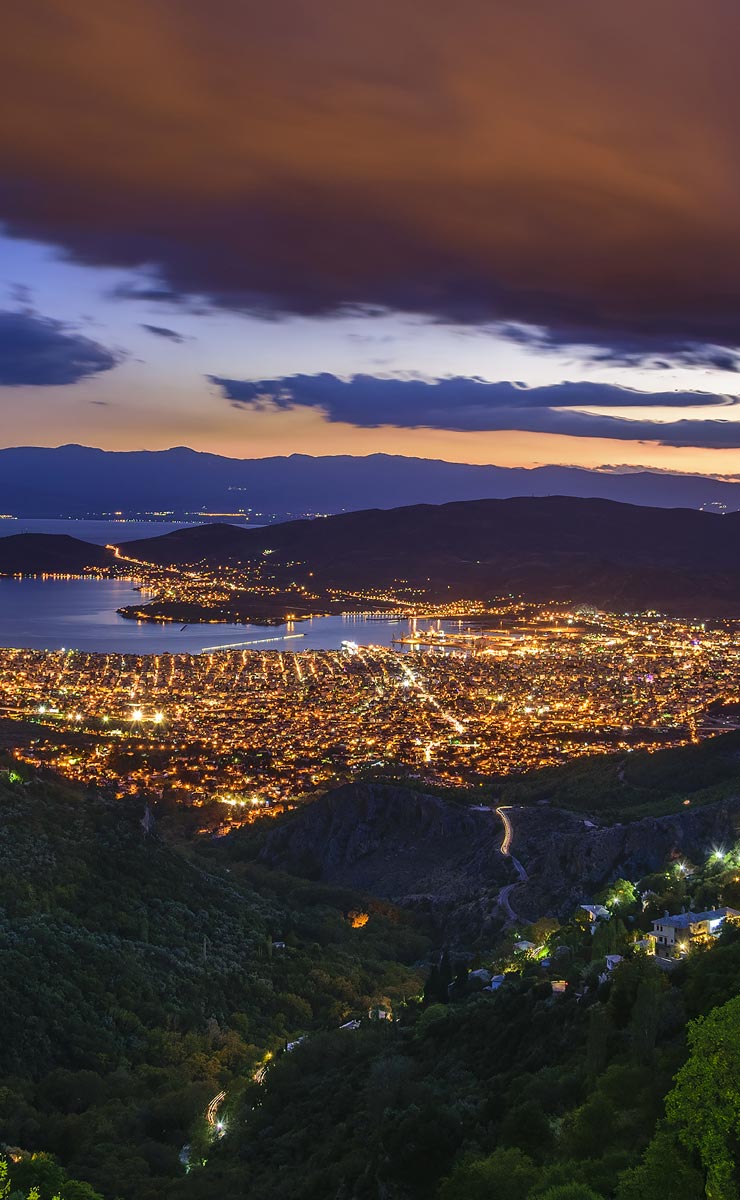Homer mentions Thessaly in the Odyssey, using the name "Aeolia." This region, in the center-east of the Greek mainland, contains Greece's largest plain, (about 100 km by 100 km), and is considered the bread basket of the country. The Plain of Thessaly was the site of the battle between the Titans and the Olympians. The plain is dominated by the farming city of Larissa, Thessaly's capital and largest city (metro pop. 300,000). Larissa is where Achilles was born, and Hippocrates, the Father of Medicine, died. It sits on the middle of the plain and bakes in the sun of high summer, often setting temperature records for Greece because of its relative distance from the sea, and from the mountains with their moderating breezes. Nevertheless this ancient city has it points of interest, including a classical-era open-air theatre and other archeological sites.
Larissa sits on the Pineios River (named after the Thessalian river god), which flows east from the Pindus mountains. It bends north after Larissa, carving out the dramatic bottleneck of the steep, narrow, 10 km-long Vale of Tempe, a chokepoint between northern and central Greece, before emptying out into the Aegean, just south of Mt. Olympus. Tempe, Arizona was named for this gorge.
To the west of Larissa, in western Thessaly, are the most southerly mountains of the Pindus Range, known as the Agrafa (un-recorded). This region of villages dotting the sides of the wild mountain fastness was never conquered or administered by the Ottomans, who also never kept tax records for the area. Between the Agrafa and the prominent small city of Karditsa to the east is the large man-made Lake Plastira, a magnet for tourists seeking cooler locations in the summer. Southeast of the lake 30 km is the spa of Smokovo, noted for its therapeutic alkaline-sulphur hot springs.
Northwest of Kardista 25 km is the city of Trikala (pop. 130,000), through which flows the Lithaios, a tributary of the Pineios. While nearby Karditsa was incorporated as a city recently (1882), Trikala was founded as "Trikka" in the 3rd millennium BC and was named for the daughter of Penaeu, the river god. Trikala is said to have been the birthplace the god of healing, Asclepius, who lived and healed there. The familiar, snake-adorned rod of Asclepius has devolved into a worldwide symbol healing.
Up the road from Trikala 20 km is Kalambaka. Sitting under the shadow of the steeply rising Pindus range at Kalambaka, on the northwestern edge of the Plain of Thessaly are some of the weirdest geological formations on the planet: stratified sandstone pillars reaching hundreds if meters into the sky, 6 of which are topped by monasteries built during the Middle Ages. Meteora is one of those places that looks like it belongs to another planet. Geologists believe the horizontal lines on the pillars are water marks from a sea which once covered the entire Plain of Thessaly.
Just south of Meteora 5 km are the Theopetra Caves, which house the oldest man-made structure in the world, a stone wall at one of the cave's mouths constructed 23,000 years ago as a defense against the last great ice age.
Traveling from west to east, southeast of Meteora 125 km, at the eastern edge of Thessaly, on the Aegean Sea, is the city of Volos (pop. 144,000), the home of Jason and some of his Argonauts. Volos is the gateway city to the beautifully green Sporades, a group of 4 main islands, plus a number of smaller ones, in the western Aegean. Volos is the only port for Thessaly and its abundant agricultural output.
Just north of Volos is the peninsula of Mt. Pelion, home of the mythical centaurs. The best beaches of Thessaly can be found along the eastern coast of the peninsula.
Mountains, lakes, seashore, archeology, mythology, weird geology, and islands. Thessaly has all of these things and more for the adventurous traveler.












